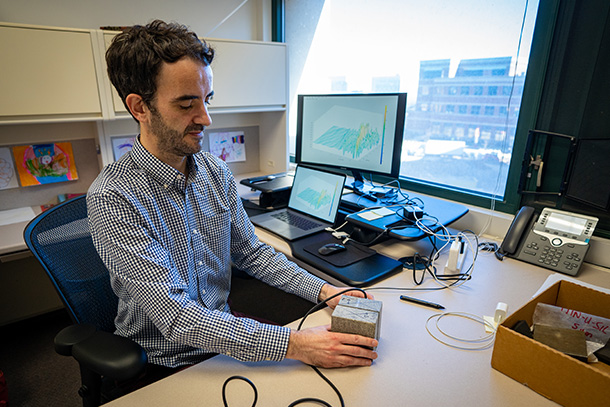
Jacques Rivière, Penn State assistant professor of engineering science and mechanics, demonstrates the technique of using lab-based earthquakes and ultrasound technology to study earthquakes and the precursory events that lead to them. Credit: Jeff Xu/Penn State. All Rights Reserved.
Researcher to image lab earthquake formation, precursory signals with ultrasound
March 15, 2023
By Mariah R. Lucas
UNIVERSITY PARK, Pa. — Earthquakes are notoriously hard to predict, and scientists currently rely on seismic hazard maps to predict the likelihood of an earthquake to strike a particular region. Jacques Rivière, assistant professor of engineering science and mechanics (ESM) and of acoustics, received a five-year, $750,000 Early Career Award from the U.S. Department of Energy (DOE) to advance the use of ultrasound sensors to image lab-based earthquakes and better understand the precursory events that lead to them.
Most known for its use in medical settings, ultrasound technology also is used in other industries to nondestructively detect defects or cracks. Using the DOE grant, Rivière plans to use ultrasound imaging to obtain details about the events taking place on a fault plane prior to a failure and use the imaging as an input to predictive machine learning models.
“Ultrasonic waves are the lab equivalent of seismic waves in the field,” Rivière said. “Ultrasound provides a direct link between what we learn from controlled lab-based earthquake experiments and seismic observations made at the Earth’s scale.”
Studying lab-based quakes allow researchers to gather data on the physics at play in an earthquake. In real life, instruments are placed at the earth’s surface, far away from the fault lines deep in the ground, which forces scientists to make simplified assumptions.
Rivière will image the fault during the formation of lab quakes using a new iteration of ultrasound, he explained.
“Rather than using a handful of sensors, as has been done until recently, why not use an ultrasonic probe, similar to a medical device, that contains hundreds of sensors?” he said. “Using a dense array of ultrasonic sensors along the fault will allow us to visualize the mechanics of how lab quakes nucleate and, in time, help us understand the precursors, or what happens before a lab quake forms.”
Even in a laboratory where experiments can be well controlled, the timing and magnitude of lab quakes depend on the fine details of the fault plane, such as the overall roughness of the blocks in contact, the presence of small, loose rock particles, or microscopic heterogeneities somewhere on the fault line, according to Rivière.
“It is now known that ultrasonic data is sensitive to all these details and provides some precursory information about an upcoming failure,” he said. “For example, the wave speed across a fault decreases prior to failure as the two rocks in contact start sliding past each other faster. Machine learning models have been built using such lab data and were successful at predicting the timing and magnitude of upcoming failures, but we don’t yet understand how and why they work.”
Rivière said he will use the ultrasonic imaging datasets as inputs to machine learning models to study the physical mechanisms and determine why past machine learning predictions work.
“The big advantage in using lab-based earthquakes is that we can create earthquakes every few seconds, which gives us a large chunk of data upon which to build a machine learning model to predict when the next failure event will occur,” Rivière said. “In the field, you would need thousands of years of data to do so, since earthquakes occur so rarely.”
According to Rivière — who was a postdoctoral scholar in the Department of Geosciences in Penn State’s College of Earth and Mineral Sciences prior to joining ESM as a faculty member — being able to improve seismic risk assessment, or even one day predict earthquakes, is essential for mitigating risk associated with the biggest earthquakes, as well as those caused by fracking, where oil and water are removed from the ground and wastewater is re-injected into the ground under high pressure.
Rivière plans to collaborate on this research with Chris Marone, professor of geosciences, Parisa Shokouhi, professor of engineering science and mechanics, and Daniel Kifer, professor of computer science and engineering, all from Penn State.



